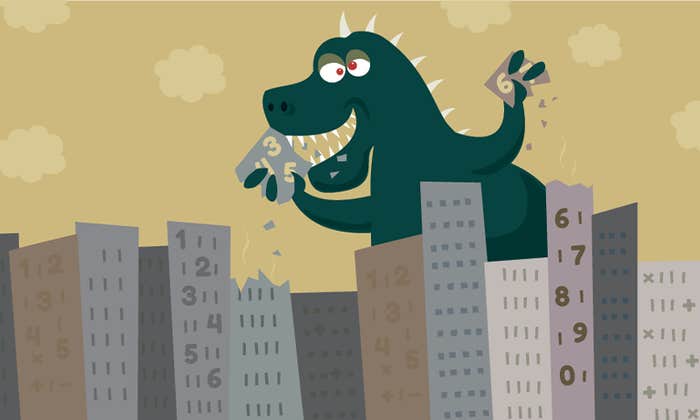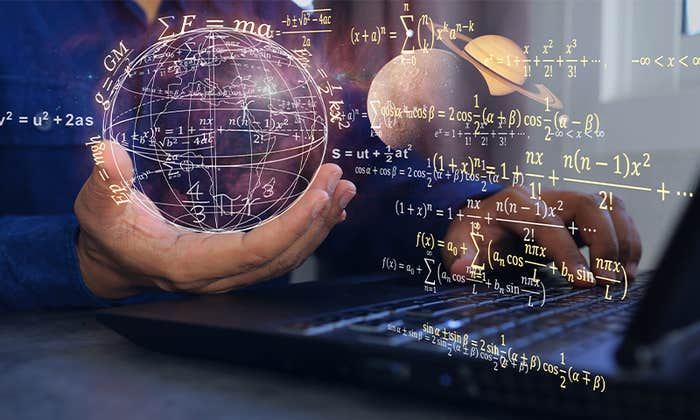In engineering, uncertainty is usually as welcome as sand in a salad. The development of digital technologies, from the alphabet to the DVD, has been driven in large part by the desire to eliminate random fluctuations, or noise, inherent in analog systems like speech or VHS tapes. But randomness also has a special ability to make some systems work better. Here are five cases where a little chaos is a critical part of the plan:
Stochastic Resonance
Scientists who make sensitive detectors often go to extreme lengths to eliminate noise. If they are trying to spot neutrinos, for example, they’ll build their detector at the bottom of a mine to stop the results from being swamped by regular cosmic radiation. But there are times when adding noise is the only way to pick up a weak periodic signal.
This phenomenon is called stochastic resonance, and it works something like this: Imagine you’re trying to count the number of waves at the seashore, and your detector is a wall built across the middle of a beach. The height of the wall represents the threshold of detection: Only if water washes over the top of the wall will it be registered. But our imaginary wall is high enough that the swell of the water never quite rises to the top of the wall. Adding noise is like adding some rapidly changing wind—it whips up waves in a random pattern. With the right amount and right variation of wind, when the wave comes in the water will splash over the top of the wall and be detected. If there’s too little wind, the calmer waves will never make it over the top; too much wind and the water level may stay over the wall for long stretches, drowning out the signal of the waves.
There are times when adding noise is the only way to pick up a weak periodic signal.
And stochastic resonance doesn’t just apply to scientific instruments: There’s evidence that our own nervous systems use it to detect signals between cells, and that it also plays a role in our perception of sight, touch, and hearing. For example, the balance of elderly people can be improved by fitting their shoes with insoles that produce “noisy” vibrations below the threshold of sensation. This improves the seniors’ sense of touch in their feet, which leads to better balance. Researchers believe this works because the sub-threshold stimulation primes sensory neurons to fire when a foot contacts the floor. The stimulation has to be somewhat random because otherwise the sensory neurons would adapt to, and ultimately ignore, the additional stimulation.
Cryptography
Codes and ciphers are a case where being predictable can literally get you killed. The goal of cryptography is to turn a message—the “plaintext”—into a meaningless jumble—the “ciphertext.” Ideally, the ciphertext should be indistinguishable from a random string of letters or numbers: If code-breakers discern any pattern in the ciphertext, they can use it to help reveal the plaintext.
For example, during World War II, Germany relied on a code machine called Enigma. An
operator would push a button on its keyboard, and a letter on a panel would light up, as determined by a system of rotating wheels inside. Crucially for the Allies, the setup was such that a letter couldn’t be encrypted as itself; that is, a “b” could be encoded as any letter except “b.” This might sound like a good thing—shouldn’t all the ciphertext be completely different from the plaintext? But in fact, it was a critical weakness, reducing the number of possibilities code-breakers had to consider.
Modern cryptography encrypts messages by combining plaintext with randomly generated
digital keys using various algorithms. The security of the system depends on the algorithm chosen, the length of the keys, and the keys being truly random. The algorithms and keys used today are so good that it should take longer than the current age of the universe to break a properly encrypted message. Nonetheless, some security-conscious individuals and organizations are worried that new code-breaking techniques may be found. Consequently, researchers have created and deployed some quantum encryption systems, which rely on fundamentally random subatomic processes and, in theory, can never be broken.
Genetic Engineering
Evolution created a noise-resistant digital code to store the blueprints of life: DNA, with its four-letter alphabet. DNA allows organisms to replicate a single cell over and over to make an entire human body composed of trillions of cells, each with an identical genome. Our cells even have elaborate systems to repair and correct damaged DNA. Consequently, although these systems can break down, as in cancer, for any given cell the chances of a DNA mutation are low. Also as in cancer, most mutations are likely to have a negative, or at best neutral, impact on the cell’s functioning. This is a problem for genetic engineers who want to produce lots of mutated cells quickly so they can find the rare variation that’s useful, like a corn cob with bigger kernels.
So they rely on mutagens. Mutagens are factors that jumble DNA, and there are a huge
variety to choose from, depending on the organism and the degree of jumbling that is desired. Exposure to gamma rays—the same thing that turned mild-mannered scientist Bruce Banner into the Hulk—is one popular mutagen, and even caffeine can do the trick, especially when working with bacteria or fungi. Fortunately for the enormous number of people for whom caffeine is one of the major food groups, its mutating powers are confined to cells in petri dishes.
Gambling
Gaming operators must walk a fine line. To keep players interested—and law enforcement agencies uninterested—their games must be fair. But they must also be guaranteed to generate a profit in the long run. Casinos need to know just how likely a 21 in blackjack or a red 32 in roulette is, so they can set appropriate payouts (or, when it comes to virtual games like electronic slot machines, what the odds of three cherries turning up should be).
This requires being able to calculate odds with precision. So it probably shouldn’t be a surprise that our modern mathematical understanding of probability came about largely because of gaming. Antoine Gombauld was a 17th-century gambler who had a friend in one of the greatest geniuses of all time, Blaise Pascal. (Among many other contributions, Pascal invented the first mechanical calculator when he was 19 years old.) Gombauld was trying to figure out the correct odds of throwing two sixes with a pair of dice, and asked Pascal for help.
To keep players interested—and law enforcement agencies uninterested—their games must be fair.
Corresponding with Pierre de Fermat (best known for his Last Theorem), Pascal worked out ways to calculate probabilities without having to tally up every possible outcome of a game one by one, something that quickly becomes cumbersome when the games get complicated. This work was the foundation of what’s now called probability theory, and is used to understand all kinds of complex phenomena, from the stock market to quantum physics.
Pascal’s analysis highlights that one reason gambling is so lucrative is that our intuitive understanding of the likelihood of a random event is often quite wrong. Imagine tossing a fair coin 10 times and, by chance, getting 10 tails in a row. Now, how much would you bet that you’re going to get another tails on your next toss? Some people think that because getting 10 tails in a row was already unlikely, an 11th tails must be extraordinarily unlikely—that heads is “due.” Other people would believe tails is on an unstoppable lucky streak, so the chances of an 11th straight tails are great. But Pascal showed us that that the odds in this case are, in fact, exactly 50/50. The coin doesn’t “remember” what’s gone before. But players remember, and they tend to believe that their luck or instincts can outsmart randomness, so they under- or overestimate their chances. The result is that a casino can be completely upfront about the odds in their games, which are a lot poorer than 50/50, and still have a steady stream of players willing to put money down: The gaming industry raked in $430 billion in 2012, according to the analyst firm Global Betting Gaming Consultants (GBGC).
Computer Simulations
Systems like hurricanes or stock markets are hard to predict because they are so complex. An analyst creates a computer model of the system she’s trying to understand, feeds in a description of current conditions, and lets the simulation evolve. Unfortunately, a lot of approximations must be made: Only so many wind-speed measurements can be taken, and no one can read the mind—or stock-trading program—of every trader.
So the analyst is left with a big question mark about how far she can trust the simulation: If she’d happened to choose slightly different starting approximations, would she have gotten radically different predictions? The way to reduce this uncertainty is the Monte Carlo method, named after the casino of the same name. The analyst runs the simulation hundreds or thousands of times, with the initial conditions randomly adjusted each time. Then she looks at the collection of predictions. If 90 percent of weather forecast simulations show a storm tracking straight up the East Coast, it’s probably time to batten down the hatches.
Generating Randomness
Creating true randomness is a lot harder than thinking of a number between one and 10. Humans can’t be trusted to do it reliably. We mistake the inevitable coincidences that arise in truly random sequences—such as the same digit appearing three times in a row—as evidence of a pattern. But by avoiding these coincidences we make sequences more predictable.
But don’t feel bad—computers are terrible at producing random numbers, too. This is because they are digital systems ruled by logic—every number the computer generates is in some way based on other numbers in its memory. On its own, a computer can’t generate a truly random number.
So when it’s critical that a computer use truly random numbers, an external source of noise must be used. These sources can include having the user jiggle their mouse around, or even odd approaches like pointing a digital camera at a lava lamp. This is often impractical, so computer scientists invented algorithms that produce pseudo-random numbers, which are close enough to truly random for most purposes. The algorithms start with a so-called seed and then generate a sequence from that. Seeds are usually relatively small numbers, so programs can either ask users to pick one, or can choose them by looking at something like the computer’s internal clock.
It’s important to statistically test these algorithms: Some poor random number generators don’t produce numbers that are evenly distributed over the possible range of numbers, which can, for example, bias the outcome of Monte Carlo simulations that rely on having a fair sample of inputs. Other poor generators have been known to produce numbers that are easily predictable: In 2003, geological statistician Mohan Srivastava worked out how to identify winning scratch tickets from the Ontario Lottery thanks to a pattern in the visible numbers printed on the ticket.
The Color of Noise
Engineers and scientists refer to all sorts of randomness in a system as “noise,” because that’s literally what it was—the audible pops, hisses, and buzzes that interfered with messages sent via the early electronic systems of telegraphs, radios, and telephones. Hence telecommunications companies quickly developed a keen interest in understanding noise and finding ways to reduce it, most famously at AT&T’s Bell Labs in New Jersey. There, in 1948, Claude Shannon published “A Mathematical Theory of Communication,” founding the entire field of information theory by thinking about the limits of transmitting information in the presence of noise.
Everybody is familiar with white noise, the hissing sound associated with static. White noise is random, in that any given sound frequency is as likely to appear as any other. This is why it’s called white noise: Like white light, it contains many frequencies evenly mixed together. But it’s not the only kind of random noise possible; there’s actually a whole spectrum of noises labeled with different colors, the most important of which are pink and brown.
Pink noise is also known as 1/f noise, which means that a frequency’s likelihood of appearing is inversely proportional to that frequency. That is, low-frequency sounds dominate over high frequency sounds. Like white noise, the name comes by analogy to colors—the low-frequency end of the visible spectrum is red, so the noise is “tinted” pink. The pattern of pink noise actually turns up naturally all over the place, most notably in music: If you plot the distribution of frequencies in many compositions, it follows a 1/f pattern.
Brown noise is similar to pink noise, except that a frequency’s likelihood of appearing is inversely proportional to the square of the frequency (1/f2). This means low-frequency sounds dominate even more than with pink noise. (This time the name doesn’t relate to visible light, but comes from “Brownian motion”—the random movements of particles suspended in a liquid or gas as they are knocked around by molecules.) Like pink noise, it turns up naturally in a lot of places—including the wiring of our neurons, although the exact role it plays is not fully understood.
Stephen Cass is a freelance science and technology journalist based in Boston, who frequently covers physics, aerospace, and computing.






























